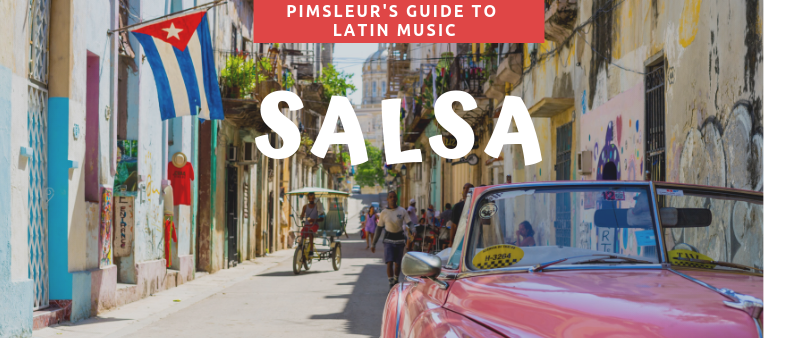
I’m sure you’ll agree that no matter where you are, Latin music is gaining speed on billboards everywhere. Ever since the reggaeton hit “Despacito” was declared the #1 video in the WORLD, attention has turned to Latin music and its irresistible sound. (Reggaeton, which originated in Puerto Rico during the late 1990s, is a mash-up of Latin American, Caribbean, and hip-hop sounds.) However, few people actually know the truth about the roots of Latin music and the impact it has had.
That’s why we created Pimsleur’s Guide to Latin Music, a six-part series that breaks down Latin music by genre and country to give you a better picture of Latin music and make you super culture savvy! In today’s episode, we’ll discuss salsa, the Latino archetype!
In this blog post, you’ll find:
- The origin of salsa music and its history
- Salsa music facts and insider knowledge that you can show off to your friends
- A salsa music playlist of classic and contemporary songs to get you dancing today!
Let’s get started!
Salsa Music Overview
Regions: Cuba, Puerto Rico, Colombia, United States
Iconic salsa music artists: Celia Cruz (Cuba), Marc Anthony (Puerto Rico), Joe Arroyo (Colombia)
It is by far the most stereotyped and misunderstood of the genres, yet it’s the most important to comprehend. When people think “Latin music” they immediately think of salsa.
Salsa Music’s Origin: Where Did this Saucy Sound Start?
If you’re thinking “hot and heavy,” it’s because the countries that produce and dance this music are quite hot (Cuba, Puerto Rico, and parts of Colombia).
The primary contributor is Cuba, which provides a seamless medley of Afro-Cuban drums and indigenous beats that represent their diverse population.
In NYC, Cuban and Puerto Rican bands have been collaborating non-stop since the mid-1900s, whipping up what the world knows today as salsa (or sauce): a tribute to the hot, spicy and mixed nature of Latin Culture.
The spice traveled quickly across the U.S. to another Latino-rich city, Los Angeles, where the LA style of salsa was born.
While the different dance styles of Cuban (aka “Casino”) salsa and Puerto Rican salsa were coming to fruition in NYC, Miami, and LA, Colombia was catching up and creating its very own fancy footwork, landing Cali, Colombia a star on the map as the best place in the world to dance salsa.
Today, all of the aforementioned places add their own distinct charm to the basic steps of salsa as the dance constantly evolves.
| MASTER TIP: DO NOT assume all Latinos dance salsa. To tell a Brazilian (who speaks Portuguese) that they dance salsa is like telling a Canadian they dance salsa. |
So Why Doesn’t the U.S. Have its Own Version of Salsa?
Wait a second: if African beats influenced the captivating poly-rhythmic sound of salsa that enchanted the world, why didn’t something similar to salsa develop in the United States?
Well, as it turns out, American slave owners weren’t too fond of African drums. They were prohibited in America during slavery. The elite feared their slaves would encode messages, plan rebellions, and/or practice satanic religions.
Why Does This Matter? Listen Up!
This is one of the BIG hallmarks of Latin music as a whole.
Salsa, among other types of music, is very vocal about its connection to African/indigenous heritage.
Take one of salsa’s most iconic historical ballads as an example: Rebellion: No Le Pegue a la Negra (“Rebellion: Don’t Hit the Black Woman”). The stories are recorded over and over to never be forgotten.
Key Takeaway!
Latin music doesn’t separate by race or genre, or even age. Being Latino inherently means being a mix, a beautiful salsa of cultures and backgrounds.
Bottom Line:
- Origin: Salsa is mainly Cuban, Puerto Rican and Colombian, with styles developed in the US.
- Where Can I Hear It: Almost every big city in the world has a salsa club. Definitely heavy in Miami, NYC, and LA, but you’ll also hear it all over Central America, the Caribbean, and La Gran Colombia (Colombia, Ecuador, and Venezuela).
- DO NOT assume that every type of Latin music is salsa or that all Latinos listen to it. (Argentinians will promptly inform you they do not!)
Check Out Our Top Salsa Dance Music Playlist!
These songs are absolute salsa classics. Be sure to play them at your next Latin party!
- Marc Anthony – “Valio La pena”
- Celia Cruz – “Quimbara”
- Oscar D’Lean- “Lloraras”
- Joe Arroyo- “En Barranquilla Me Queda”
- Víctor Manuelle- “Tengo Ganas”
- Luis Enrique- “Yo No Se Manana”
- DLG- “Juliana”
- Grupo NIche- “Cali Pachanguero”
Explore more sounds of the Latino culture, check out other articles in our Latin music series!
- Pimsleur’s Guide to Latin Music: Reggaeton
- Pimsleur’s Guide to Latin Music: Bachata
- Pimsleur’s Guide to Latin Music: Merengue
- Pimsleur’s Guide to Latin Music: Cumbia
- Pimsleur’s Guide to Latin Music: Latin Rock
Special Offer for Salsa Lovers
Brush up on your Spanish and sing along to your favorite salsa tunes – Use code BLOG at checkout for a caliente discount!
No Comments for "Salsa – Pimsleur’s Guide to Latin Music"